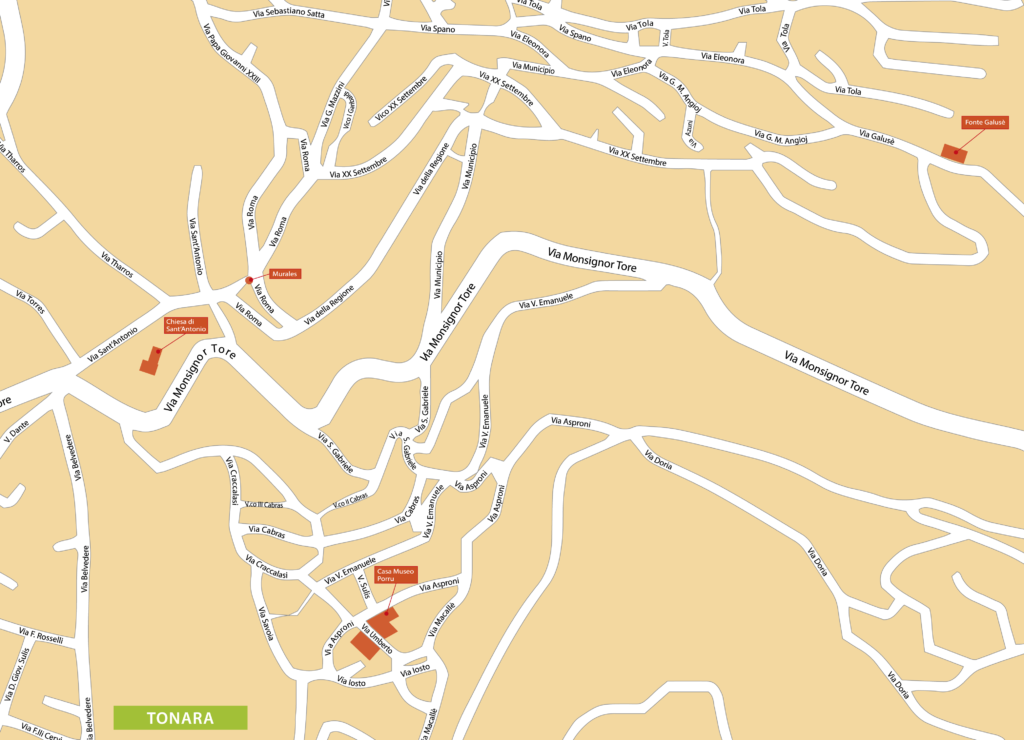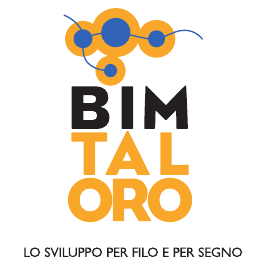Church of Sant’Antonio da Padova
The Church of Sant’Antonio da Padova is located in the village of the same name, between the districts of Arasulè and Toneri and the new neighbourhood of Su Pranu. It was allegedly built in the 16th century — according to some sources, a wooden pulpit was erected in 1513, even if no trace of it remains today. However, other sources date it to the 17th century (during the Spanish domination), or to the late 17th/early 18th century. The church is built from local materials (mainly schist) and is quite simple in appearance. At the top of the main facade, which was probably renovated in the 19th century in a classical style, is a cornice; along the two sides are portions of wall, each surmounted by a small bell gable. The front of the church is quite plain: above the main entrance, flanked by lesenes, is a rose window decorated with bas-reliefs, while the side walls, which are supported by buttresses, have small, semicircular windows. The front of the church is painted yellow and looks just like the mural made in 1999 by Ezio Marietti on the wall of the nearby library, depicting a procession in honour of the Saint with men and women dressed in traditional clothes. In the past, the courtyard was closed with a gate, thus creating an elliptical space as was typical for the sanctuaries of the Barbagia area, with the church at the centre and the dwellings for novenantes (i.e. pilgrims) running along its perimeter (as a matter of fact, there were some cumbessias, i.e. dwellings for pilgrims,in the area surrounding the church). In this courtyard, the inhabitants of Tonara returning from the Italo-Turkish War planted two rare Aleppo pines at the end of 1911; today, only one of them still survives, since the other one had to be cut down to avoid damage to the façade.
The church has an asymmetrical Latin cross plan and consists of a single nave with two side chapels known as del Carmine and del Rosario, which were renovated in 1859. The chapel on the right houses a relic of St Anthony that was donated by the city of Padua in 2022 and is now kept in a reliquary built by local artist and carpenter Peppino Murgia. The nave has a barrel vault and is divided into three bays by pillars and round arches: the pillars are plastered, while the ribs of the arches are of exposed sandstone brickwork; the arches dividing the two chapels from the nave are of exposed red brick instead. All the walls are painted white, except for the soffit and the presbytery, which is raised above the hall and features three niches with three small statues (St Anthony stands in the central niche, surmounted by a lunette, flanked by St Ignatius of Laconi to the right e Blessed Nicholas of Gesturi to the left). The ogival vault is decorated with some beautiful frescoes depicting the life of the saint (preaching to the fish, the miracle of the mule, the miracle of his parents, the battle against the devil, the miser’s heart; an oval medallion in honour of St Francis Xavier, co-founder of the Society of Jesus, is also present). These wall paintings, which date back to 1750 and were restored in 2011, serve as decoration, teaching tools, objects of devotion and a warning (i.e. an exemplum for people). They were made by Gregorio Are, son of Pietro Antonio: the two artists, who ran a workshop in the first half of the 18th century, made similar works in other churches of the Nuoro province such as the church of Nostra Signora delle Grazie in Nuoro, the church of Santa Maria dei Martiri in Fonni, the church of Santi Cosma e Damiano in Triei, and the church of the Rosario in Orani.
The church, which is open and can be visited all year round, comes to life during the festival in honour of St Anthony of Padua. Two different committees are in charge of organising the liturgical services and events: one for the celebrations of June 12 and 13, and the other one, which includes torrone (Italian nougat confection) manufacturers and vendors, for the celebrations of the so-called Ottava, on June 19 and 20. This second date was allegedly established by the street vendors themselves, who in the past could not attend the festival since they were often travelling throughout the country. The celebrations of June 13 include splendid and heartfelt masses ending with a procession from the church all the way through the Su Pranu district; another procession takes place on the eve of the Ottava. In the 19th century, a horse race was held on this day and the winning riders were awarded a piece of black or blue velvet that was 8 metres long. On 9 January 1921, David Herbert Lawrence had the chance to stop by the church and have a look inside, as he wrote in his world-famous work Sea and Sardinia, where he included the detailed description of a procession of men and women dressed in the traditional Tonara clothing and described this church as a “grey, forlorn little church on the ridge-top”.
Text by Cecilia Mariani

 BIM TALORO
BIM TALORO